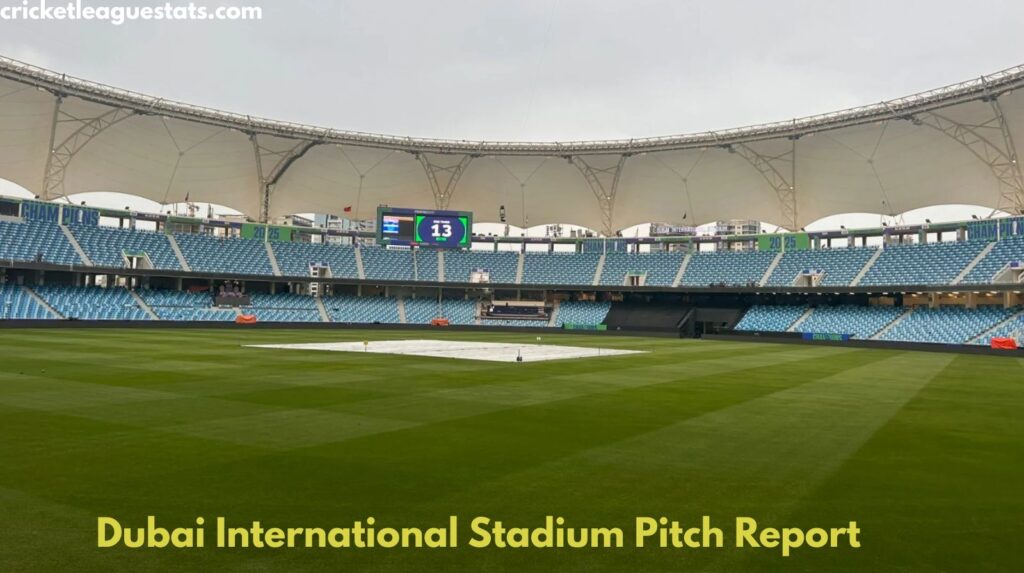And yet, for all its lack of razzle dazzle, the Dubai International Stadium has so much more to it than cricket; it is part of what you might describe as the modern-day gladiator’s coliseum. Lovingly referred to as the ‘Ring of Fire’ because of that unique ring of lights around its façade, this stadium has quickly grown into an iconic cricket hub on the global stage – a second home for many a team and arguably the best venue – from an atmosphere point of view – for his big stage act, the Indian Premier League (IPL). Yet behind all that glittering and roaring fanfare, the most important character in each battle is represented by that patch of grass: The pitch.
To decipher the Dubai International Stadium pitch is to break the code. The Dubai pitch unlike certain grounds with patterns, has changed up and provided a very interesting mix of opportunity and challenge. In this wide-ranging report the fine qualities of the 22-yard stretch from each team’s perspective, what players should to do work it out and how fans can enjoy them.
The Anatomy of the Dubai International Stadium Pitch
The track at the Dubai International Stadium is a stereotypical Gulf beauty, being prepared over an almost-soil base which tends to dry up and assists in spin as the game wears on. But calling it a “spinner’s paradise” is too simplistic. The behavior of the bear is influenced by time, format and the weather.
The T20 Dynamo: A Batting Beauty with a Second-Act Twist
In this fast-paced world of T20 cricket, the Dubai deck usually begins as a belter. The ball is coming on to the bat well, batsmen are able to play through the line. Its True Bounce and pace make it an ideal place for fine stroke play. The side boundaries are shorter which lets the batsman hit across the line.
But there’s more to come in the second innings. All of this takes its toll as the match progresses, the pitch loses its zip. It doesn’t come on to the bat as nicely and with the dew factor (in evening games) gripping it can be tough for bowlers. This is where it gets interesting. As pacers with variations (read slower balls, cutters) become key, spinner who can bowl accurately and also alter their pace get a huge purchase. The pitch typically turns a little more as the game wears on, so the middle period becomes an important tussle between batsmen looking to open up and spinners aiming to dry things up.
Read More: Sunrisers Hyderabad vs Rajasthan Royals Timeline
The ODI Character: A Game of Two Halves
In the 50-overs version the double character of the pitch is even more in evidence. First innings commonly go for big scores, who are regularly on a score of 280-320. The hard flat pitch help batting for the first couple of hours (30-35 overs). As the innings wears on, so does the pitch and into action slip the spinners, attempting to break partnerships and stem run-rates at end of innings.
Chasing under lights in ODIs is a challenge. Although the ball still comes on to the bat, there is a bit of wear and tear from the first innings. The spinners are able to get a lot more turn, and the pacers who can reverse the old ball become deadly. While two early wickets may seem simple, the team batting second needs a target that keeps them in the game through at least 12-13 overs, and must manage their middle period carefully.
The Test Match Challenge: A Deteriorating Battle of Attrition
Test While less favoured as a Test venue, the Dubai pitch in the longest format rewards patience and skill. It’s probably a very good batting pitch to start with, true bounce and value for strokeplay. But days two, three, and four come around, the crust starts falling apart. The wicket will show the soil, it is fairly dry and should give a good amount of turn to quality spinners. Pacers who are able to hit the seam consistently also get uneven bounce as game progresses and batting gets tough. A Test match here is a war of attrition through and through, one where winning the toss and batting big in the first innings is usually what matters most.
Key Factors Influencing the Pitch Behavior
- Dew: A huge factor in evening games, the dew takes pacers’ swing out of the equation and makes it near-impossible for spinners to grip the ball, tipping the balance heavily in favour of the team batting second.
- Heat and Humidity: The harsh conditions can sap the strength of the players and affect the condition of the ball, which helps reverse swing later in an innings.
- Pitch Preparation: The groundsmen can leave from little to many grass which will change the character of the pitch, providing more help for the seamers at times early on.
Statistical Snapshot: Dubai International Stadium Pitch Trends

The following table summarizes the key statistical trends across formats, providing a data-backed view of the pitch’s behavior. Dubai International Stadium Pitch Analysis Table
| Format | Average 1st Innings Score | Highest Team Total | Lowest Team Total | Predicted Toss Decision | Most Successful Bowler Type |
|---|---|---|---|---|---|
| T20 International | 150 – 160 | 211/6 (SL vs. PAK) | 55/10 (WI vs. ENG) | Chase (Due to Dew) | Pacers (in Powerplay), Spinners (Middle Overs) |
| ODI International | 250 – 270 | 284/7 (AFG vs. PAK) | 112/10 (SL vs. PAK) | Bat First | Spinners (Economy) & Death Over Specialists |
| IPL (2020-2021) | 160 – 175 | 219/2 (MI vs. CSK) | 81/10 (RCB vs. KKR) | Chase (Overwhelmingly) | Spinners & Pacers with Variations |
Player & Team Strategy: Mastering the Dubai Conditions
Success in Dubai isn’t accidental; it’s strategic. Here’s how teams and players approach the game:
- For Batsmen:
- Powerplay: Capitalize on the fielding restrictions. The ball comes on nicely, so playing orthodox shots and targeting the gaps is fruitful.
- Middle Overs: This is the phase of risk management. Rotating the strike against spinners is key, while punishing any loose deliveries. Batsmen who can use their feet against spin excel here.
- Death Overs: With the pitch slowing down, power-hitting and premeditated shots become crucial. Players with a strong bottom-hand and those who can clear the long boundaries are assets.
- For Bowlers:
- Pacers: The new ball offers a bit of swing, but accuracy is paramount. As the game progresses, mastering the slower ball, the knuckleball, and wide yorkers is essential. Bouncers can be effective due to the true bounce.
- Spinners: They are the kingpins of the middle overs. Accuracy, varying pace, and bowling a tight line are more important than extravagant turn. Leg-spinnDoing well in Dubai is no accident; it’s by design. Here’s how teams and players think about the game:
- For Batsmen:
- Powerplay: Take advantage of the field restrictions. The ball is coming on to the bat and playing orthodox shots and hitting into gaps has proved productive.
- Middle Overs: This is the period of risk management. Rotating the strike against spinners is vital, while also taking advantage of any loose balls. Batsmen who can get to the pitch against the spin flourish here.
- Death Overs: The pitch eases up, power hitting becomes important and so does premeditated shots. Those who are strong off the back hand and can clear long boundaries are assets.
- For Bowlers:
- Pacers: The new ball does a bit but line is crucial. As the game progresses, ability to bowl at slower pace, knuckle-balls and wide yorkers come in quite handy. Bouncers might work because of the natural bounce.
- Spinners: They are the middle overs kingpins. Line, not extravagant turn, accuracy and changing pace are key. Variations with the leg-spin and left-arm orthodox have been a great asset to buffet the batsmen off their rhythm.
- For Captains:
- Toss: Chasing is nearly a norm in T20s due to dew. Batting first and putting a total on the board is regarded as preferable in day games and ODIs.
- Field Placements: Overly attacking fields in the powerplay and containing fields in the mid-overs with protection on boundaries. The long straight boundaries also allow captains to keep the field up on the off-side for spinners.ers and left-arm orthodox bowlers have found great success by disrupting the batsmen’s rhythm.
- For Captains:
- Toss: In T20s, the decision is almost always to chase due to dew. In day games or ODIs, batting first and putting a score on the board is preferred.
- Field Placements: Aggressive fields in the powerplay, followed by containing fields in the middle overs with protection on the boundaries. The long straight boundaries allow captains to keep the field up on the off-side for spinners.
Read More: KKR Vs MI Head-to-Head in IPL, Records, Stats & Results
Conclusion: The Ultimate Sporting Chessboard
Dubai International Stadium Pitch Report is a sparkling multi-faceted challenge. It refuses to be stereotyped. It gives reward to courageous, tests the technically accomplished ones and unnerves apathetic. From a sun-drenched batting paradise to an engrossing slow-burning thriller under the lights of one of sport’s most iconic ‘Ring of Fire’, it makes for compelling modern day cricket.
It’s a pitch that commands respect, and adaptation. The teams that do well here are those that suss the conditions out fast, manage their resources efficiently and execute skills in adverse circumstances. It’s not just an open square of grass; it’s the biggest sports chessboard on our planet, where games are decided by cunning planning and execution..
FAQs About Dubai International Stadium Pitch Report
Q1: Is the pitch a batting or bowling track at Dubai?
A1: To be honest, it’s pretty even but on the batting side of things at least in a T20 first innings. It will take even more turn and it is yet another pitch which suited the bowlers, spin and subtle pace.
Q. 2: Why on T20s teams like to chase at the Dubai International Stadium?
A2: The dew is the reason. During evening games it gets dewy in the outfield and on/around the pitch, causing the ball become wet and slippery. This makes it very hard for bowlers (especially spinners) to grip the ball and bowl as they would like, which is a big plus for the team batting later.
Q3: What kind of bowlers have been very successful in Dubai?
A3: Anybody can become successful with skill, the more successful styles are; Spinners who could land it consistently and vary pace in the middle overs.
Quickmen who bowl a range of slower balls, cutters or can land their yorkers down the end.
Q4: What is the par score for team batting first in a T20 match at this ground?
A4: A competitive pass score on an average pitch is usually around 160-175. But that can vary depending on what pitch is being used, which teams are playing and how much of a factor the dew will be. A fresh pitch, 180+ is more than a good total.
Q5: Does the pitch play differently in day games and day-nighters?
A5: Absolutely. Daytime, with no dew (which happens more so in the blazing afternoon sunshine of day games) is a truer contest. The pitch typically breaks up as the game goes along to help the spinners. In day-night matches, the dew factor turns the equations upside down – chasing becomes much easier and in turn, tilts the balance towards them for sides opting to bat second.



